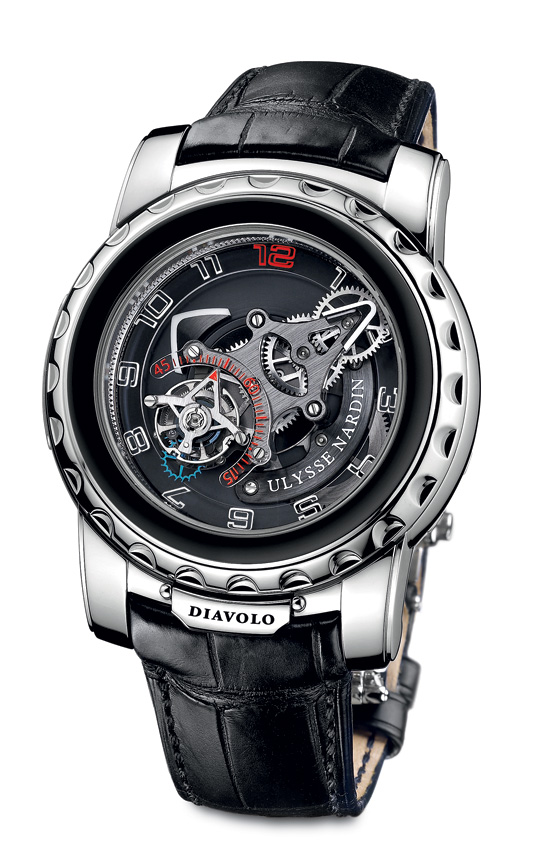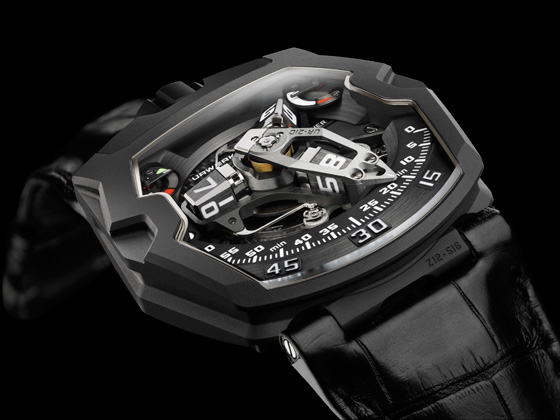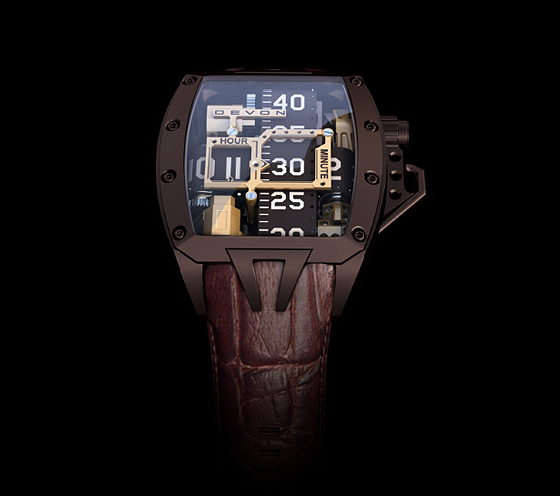The vast majority of watches stick to best sale replica watches uk traditional hour and minute hands to display the time, but a handful of bold manufacturers use their technical prowess to find new, innovative, and often downright audacious methods to indicate the hours, minutes, and occasionally even other functions. Below is a list of unusual watches that deviate from the conventional time-telling style, finding creative alternatives to hour and minute hands.
Introduced at Baselworld 2013, the HM3 Megawind by MB&F features a movement designed by Jean-Marc Wiederrecht that features an oversized “battleaxe” rotor. As with other MB&F “horological machines,” the hour and minute are indicated by revolving cones, machined from solid blocks of aluminum to paper thinness, housed inside larger cones made from brazed gold and sapphire. Click here for more info on the watch.
HYT’s H1 does away with the hour hand, instead indicating the hour by means of a green liquid that flows through a tube along the edge of the dial. This unconventional watch is famous for being powered by a system of bellows used to pump the liquid forward. Click here for our detailed analysis of how the HYT H1 works.
A year after it introduced the H1, HYT brought out the H2 model (titanium/white gold version below), which added three additional functions: a power-reserve indicator, a temperature indicator and an “H-N-R” indicator. The latter is connected to the crown and tells the wearer which position the crown is in — H for setting the time, N for neutral, and R for winding (remonter in French).
Christophe Claret’s X-TREM-1 features buy fake watches online a tourbillon and uses magnetic fields to create the illusion of hour and minute indicators floating through the air. Two small steel spheres – hollowed to make them lighter – are encased within two sapphire tubes placed to the right and left of the caseband and controlled by precision magnetic fields generated by two miniature magnets moved by cables. The position of each sphere indicates the hour and minute.
One of the most unconventional timepieces in the always-innovative Harry Winston Opus collection is the Harry Winston Opus XI, with its futuristic, moving dial. Every hour, on the hour, in the span of 2 or 3 seconds, the numerical hour display – a system comprised of a multitude of wheels, pinions, arbors, bearings and tiles – disintegrates into utter chaos and then returns to order for the remainder of the hour. Click here to discover how this watch’s miraculous movement pulls off this feat.
The most recent Harry Winston Opus watch, the Opus XIII, debuted at Baselworld 2013 and offers another off-the-wall method of telling time. It sports 11 triangular hour hands around the dial’s center that retract at the end of each hour, and 59 little minute markers that pivot toward the center of the dial as a new minute begins. Click here to watch a video displaying how this watch works.
In 2006, Jacob & Co. ventured into haute horlogerie (courtesy of now-defunct BNB Concept) with the groundbreaking Quenttin watch, which featured a 31-day power reserve, a vertical mechanical movement and a vertical tourbillon.
Ulysse Nardin’s Freak Diavolo tells the time via “hands” which are really parts of the watch’s movement, with a flying tourbillon indicating the seconds. To set the time, one has to rotate the bezel rather than setting the “hands” via a crown.
As expected form Urwerk, the unconventional brand’s UR-210 “Maltese Falcon,” eschews traditional hands for a set of rotating “satellites” to indicate the time. The watch also contains an “efficiency indicator,” which indicates winding efficiency.
The Devon Tread 2 (shown here in the new chocolate-toned “Godiva” model) displays the time by means of horizontal and vertical belts, made from a strong, flexible nylon material used in airplane luxury fake watches sale cockpits and operated by an electronically controlled pulley system.


